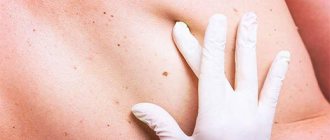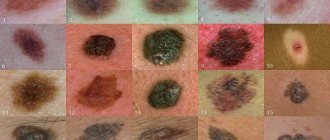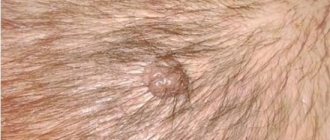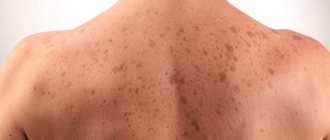Where does a mole begin?
Nevus is considered a benign skin neoplasm, characterized by an accumulation of nevocytes, melanin-rich cells.
This is why the mole has a dark color and fairly clear boundaries.
The transformed melanocytes (nevocytes) take up the thyroid hormone thyroxine and transform it into melanin, which colors the skin in a certain area.
Melanin is necessary for the human body.
It is both an antioxidant and a predictor of anti-stress hormones, softening emotional reactions, and a regulator of sleep and wakefulness.
To be or not to be a mole is determined in the embryonic period, even if the pigment formation appeared after birth.
Some features of pregnancy stimulate the process of melanocyte transformation.
The nevocyte does not have processes, therefore, like a stingy knight, it accumulates all the melanin without giving it to other areas of the skin. You can be born with moles or acquire them during periods of hormonal crises: puberty, pregnancy, menopause, unsuccessful selection of contraceptives.
As well as intense tanning, including in solariums, skin infections, allergies.
Nevocytes form a border nevus at the border of the superficial and deep layers of the skin. then grow into the dermis (mixed or intradermal nevus).
A border nevus is a round, dark, smooth spot.
The mixed one protrudes slightly above the skin.
An intradermal nevus looks larger, rising like a dome on a small stalk, sometimes with hairs, that is, it looks like a dark wart.
The main danger of a nevus is that its cells can become malignant and malignant.
Melanoma, a very dangerous malignant skin tumor, can develop from a melanocytic nevus.
80% of deaths from skin cancer occur with melanomas, although almost all patients who receive timely treatment live quietly for 10-15 years before a new relapse.
Risk factors for malignancy are known.
These are heredity (melanoma or other oncology), ultraviolet radiation (permanent or excessive tanning), sunburn, fair skin and red hair.
Gella, the heroine of The Master and Margarita, could have a predisposition to melanomas.
Let's look at some complaints related to moles.
Why does a mole bleed?
According to medical classification, moles are classified as simple nevi (lat. Naevus). This is a benign formation, which is a natural accumulation of the melanin pigment, which gives it its brown color. The number of moles on the body is determined by hereditary factors. Nevi are divided into flat and convex, and can have different sizes and shades (light or dark).
Convex types are most often subject to injury, and many people are very frightened by the situation when blood comes from a mole. There is even an opinion among people that due to damage a malignant tumor may grow. However, research by scientists proves that there is no connection between these facts.
In their opinion, the processes occurring with the mole (changes in shape or color) should cause concern - they may indicate the beginning of the development of oncology. Therefore, you should regularly monitor the condition of such formations, and at the slightest suspicion, contact specialists for help.
Doctors recommend: if a mole is bleeding, then you should take the necessary actions to stop the bleeding, and then monitor its condition.
Injury to nevus
Experts strongly do not recommend touching accumulations of pigments on the body: trying to burn them out, bandage them, or use folk recipes to remove them.
However, often mechanical damage, when blood begins to flow from a mole, occurs for natural and accidental reasons:
- a cut occurred during depilation on the face or elsewhere;
- the nevus was torn off after it caught on clothing (collar, belt, etc.);
- injury from physical activity, such as drying off with a towel after a shower.
“I picked a mole and it started bleeding”
A person gets used to his moles, chooses clothes, adapts and almost does not notice.
But the mole reminds you of itself, sometimes in a dramatic and even bloody way.
What's happening?
The man says this:
- “I scratched my mole until it bled”
- "knocked off with clothes or nails"
- “damaged a mole” and “bleeded”
- “The cat scratched a mole until it bled”
- and even “the mole burst.”
What to do and what are the dangers?
Blood comes from a mole because the nevus is penetrated by capillaries.
There are also vascular nevi or hemangiomas; they are completely filled with blood.
When to remove moles
Having figured out the best way to stop bleeding from a mole, it is recommended to consult a doctor about further removal of the nevus. Removal of damaged nevi is necessary in order to conduct a histological examination, which allows timely detection of the onset of degeneration of the spot tissue.
Doctors recommend removing moles that are often subject to friction, pressure or other damage in everyday life.
The removal procedure is absolutely painless and does not last long. If further examination of nevus tissue is necessary, the method of surgical excision is used. The doctor administers anesthesia and removes tissue using a scalpel. Stitches are placed on the resulting wound and after a while it heals without a trace.
The fastest and most painless method of removing spots is laser excision. This procedure lasts no more than three minutes. After removal, a small depression is formed, which eventually becomes covered with a crust. The method does not leave scars.
Damage to a mole: causes
- scratching with nails when combing
- chafing and bleeding due to pressure from clothing or shoes
- cutting with a sharp object in everyday life or for the purpose of “removing a mole” at home
To prevent injury to the nevus, non-compressive clothing is selected, and the mole itself is sealed with a bactericidal plaster.
But what if an injury does occur?
Firstly, like any wound, a cut or damaged nevus can become infected.
Microorganisms enter its cavity and penetrate deeper, causing inflammation.
Damage protection
No one is immune from accidental damage to a birthmark. Having encountered discomfort and bleeding once, it is important to be able to protect other nevi from negative effects.
For this purpose it is recommended:
- avoid ultraviolet irradiation of the mole;
- protect moles with a band-aid when wearing tight clothes;
- avoid accidentally scratching nevi;
- be careful while shaving.
Using UV protection when going outside during periods of increased solar activity will help prevent the degeneration of birthmark cells.
Blood began to flow from the mole - this is a situation that occurs when the nevus is damaged. You should properly treat the wound, then consult a doctor. The likelihood of degeneration into a malignant formation is low, but what happened cannot be ignored. Every person has birthmarks, and in most cases their existence does not cause any inconvenience.
Symptoms of inflammation of a mole
- pain;
- redness, diffuse or with the formation of a dense red cushion;
- local increase in temperature;
- subsequently suppuration is possible.
If the inflammation is not treated, the wound from the mole can heal by secondary intention, that is, with the appearance of an ugly scar.
Inflammation can spread to neighboring areas, and then the most dangerous injury to moles on the face and neck.
In particularly unfavorable conditions, the process generalizes. that is, sepsis develops, a general blood infection.
In place of the injured nevus, new moles and spots appear, which can spoil the appearance.
If the location contributes to the traumatization of moles (on the fingers, on the neck, on the belt), this process can be repeated again.
The most unpleasant consequence of injury is malignancy of the nevus.
Therefore, even if you easily coped with the bleeding, inflammation did not develop, you still need to consult a specialist.
Removal of nevi
There are several ways to get rid of moles:
Prevention
Moles rarely transform into melanoma, even when they have been injured more than once. However, if there are additional symptoms, in addition to bleeding, degeneration is possible. To prevent serious consequences, it is important to pay close attention to nevi and try to protect them from subsequent damage. When taking a bath or shower, you need to use the washcloth carefully and do not press it with increased force, so as not to catch the growth. You also need to be careful when removing hair, whether through waxing or razor removal. If the formation is located on the head, then the combing procedure is carried out as carefully as possible, and the comb is changed to a softer one.
You will also need to avoid aggressive exposure to sunlight. They have a particularly adverse effect on moles that are injured and bleeding. Doctors recommend that such patients not sunbathe without using special sunscreens. In addition, if the nevus is located on the face, it would be useful to use cosmetics with an SPF filter. They are recommended to be used not only on the beach or when going to the solarium, but also in everyday life. This is due to the fact that ultraviolet radiation reaches people in the city, even in cloudy and rainy weather.
Moles (the medical term is “nevi”) are on every person’s body. They are mostly benign formations, have a round shape, can be convex or flat, and are most often brown in color.
For some, moles are a decoration on the body, for others they cause trouble if they are located in inconvenient places.
And sometimes they can even pose a danger to human life.
- All information on the site is for informational purposes only and is NOT a guide to action!
- can give you an ACCURATE DIAGNOSIS !
- We kindly ask you NOT to self-medicate, but to make an appointment with a specialist !
- Health to you and your loved ones!
This is especially true for injured moles.
Therefore, it is important to know what to do if nevi are damaged and how to stop bleeding from a mole.
What other possible signs of malignancy can be seen with the naked eye?
- the nevus grows rapidly;
- the mole hurts, itches, goes numb;
- the mole changes shape: the borders blur, change outline, the surface becomes lumpy;
- many new moles appear;
- the mole darkens, turns blue or red;
- hair on the nevus is actively growing;
- the nevus gets wet;
- the mole is bleeding.
If you notice one or more changes, especially bleeding, you should contact your oncologist as soon as possible.
Melanoma is treatable in the early stages.
Why is it dangerous?
Every person develops moles throughout their life. Most often, such a predisposition is transmitted genetically, but sometimes they appear with excessive sunbathing or solarium use. When such formations remain unchanged for many years (do not change shape, size or color), then this is normal. However, their condition should be constantly monitored, recording the slightest changes.
There are 5 signs by which doctors recommend identifying an increased risk of melanocytic nevus and possible degeneration into a malignant tumor:
- the formation increases in size or changes color (darkens);
- hair falls out of it;
- the shape becomes asymmetrical;
- the surface has become uneven or bumpy, the mole is bleeding, ulcers appear;
- When touched by hand or clothing, unpleasant painful sensations appear that were not there before.
If such signs appear, you should immediately contact a dermatologist and undergo an examination. This will allow timely detection of the appearance of malignant cells in the nevus. Experts classify 3 forms of skin cancer: basal cell carcinoma, carcinoma and melanoma. Only oncologists can correctly identify the disease.
Important information: How to treat abnormal uterine bleeding and its classification
Blood from a mole: what to do?
There are a variety of reasons why a mole may bleed, but regardless of the reason, you should take the same steps.
- If the mole is not completely torn off, it is forbidden to cut it off or separate it manually.
- Wash your hands, wipe them with an alcohol wipe, cologne or vodka.
- Treat the surface around the wound with any skin antiseptic. This could be the same alcohol wipe, an alcohol solution of iodine, green brilliantine, fucarcin, or any preparation intended for hand treatment.
- Drop a 3% solution of hydrogen peroxide, chlorhexidine or miramistin (optional) into the wound.
- Cover the wound with a stick-on bandage, an adhesive plaster with a bactericidal “pad”, and fix the part of the mole that has not completely separated in a comfortable position.
What to do if a mole is ripped off
If a person has ripped off a mole until it bleeds, you should know exactly how to eliminate the risk of developing negative consequences. Blood may flow from the resulting wound for a long time. It is necessary to treat the area using hydrogen peroxide and brilliant green. Iodine and alcohol are prohibited.
Treatment differs from standard wound care recommendations. The site of injury will turn red and may itch. Picking off the resulting crust is strictly prohibited.
Repeated intervention by a specialist is required when bleeding recurs periodically and suppuration occurs. The bandage is soaked with a white liquid of viscous consistency. You cannot specifically wet the wound; the doctor will give recommendations on how to treat it.
In some cases, a specialist advises to completely remove the formation, eliminating the risk of dangerous consequences:
- With a significant increase in size, redness, darkening, increased body temperature.
- Almost torn nevus should be completely cut off.
- Indication for removal is a violation of the integrity of the skin around the damaged area.
- The location of the spot is at the site of permanent injury. If a person constantly scratches it, tears it, touches it with clothes, removal is indicated.
How to stop bleeding from a mole?
If the blood does not stop on its own during bandaging, it means that the nevus has grown into relatively large vessels and they are injured or you have poor blood clotting.
Bleeding from capillaries is stopped by pressing the vessels.
Place a sterile napkin on the wound, press tightly on top with a piece of cotton wool or a rolled bandage (this is called a “pelote”) and secure the bandage.
Depending on the location of the injury, you may be able to apply a tight bandage or simply apply pressure to the area with a few strips of adhesive tape.
Once you have given yourself first aid, don’t stop there!
Make an appointment with an oncologist or dermatologist.
The nevus must be examined to ensure that there is no gold contamination.
It is advisable to remove the mole.
If the mole “falls off” but there is no blood, perhaps the outer part of the nevus has become dead and separated spontaneously.
In this case, it is advisable not to delay a visit to the dermatologist, since the causes of necrosis are unclear.
Place the separated part in saline or boiled water and save for histological examination.
Do I need to see a doctor if a mole bleeds?
If you are bleeding from a mole, then you need to see a doctor! If a mole bleeds blood, then something is wrong with it. When blood starts coming from the ear, everyone goes to the doctor, but why should moles be an exception? On the contrary, bleeding from a mole is a call to visit a specialist as soon as possible.
If you often notice that you touch a mole, that it interferes and creates discomfort because of this, then such a mole must be removed, preventing it from starting to bleed. If blood is already flowing and the mole is torn off or simply injured, then most likely your doctor will advise you to remove it in order to prevent the development of a malignant tumor. The risk of such a development is small, but it always creeps up unnoticed, so it is worth insuring yourself against difficulties. In addition, if you remove the disturbing mole, you will be able to feel more confident and calm, because... you will know that this problematic mole will no longer cause trouble.
In general, when visiting a doctor with a complaint such as bleeding from a mole, the patient will take a stripped mole or part of it for tests to find out whether the mole is dangerous and whether it will cause the development of skin cancer. Depending on the diagnosis, the doctor will decide whether to remove the mole. But, if it bothers you and you tore it off, then of course it would be better for you personally and your convenience to remove it.
Why else should you see a doctor if a mole bleeds? The fact is that you can stop the bleeding and even calm down after this or even not pay attention to what happened. However, a mole you pick off can trigger a long or rapid process of the transformation of a benign mole into a malignant tumor. For this reason, it is important to get tested to understand what you have torn off - a simple and harmless mole or melanoma (malignant tumor).
It happens that a mole is torn off not with one’s own hands, but during children’s games with each other or with animals. In this case, it is even more important to contact a specialist, because during this, an infection could be introduced to the injury site, which should be removed and eradicated as soon as possible.
A visit to the doctor cannot be delayed for a long time due to injury to a nevus - it is important to understand that if a mole bleeds, this is not normal. It’s one thing when it gets caught in underwear or a person accidentally damages it with a fingernail, which also shouldn’t be done, but another thing is further prolonged bleeding, which can indicate a dangerous disease.
Diagnosis of a mole (nevus)
A dermatologist performs an external examination of the wound, first without equipment, and then using epiluminescence dermatoscopy.
A biopsy (removal of part of a mole for examination) is not performed, since repeated injury to the nevus is unsafe.
After consulting an oncologist, they decide where exactly the mole will be removed.
The ideal specialist in this case is an oncodermatologist.
But if there is none, you can sequentially visit two medical organizations: dermatovenereal and oncology dispensaries.
After the operation, the material is necessarily sent for histological examination.
It is this that gives the answer to the main question: has a “peaceful” mole become malignant?
When to see a doctor
You should shave your face, intimate areas, and areas where moles are located carefully - no one is immune from injury. Damaging hanging nevi is more dangerous; you should treat them carefully and treat them correctly. In some cases, specialist consultation is necessary:
- The bleeding doesn't stop. It weakens, then resumes again.
- Some people may develop a fever. Reason to seek help at the hospital.
- Redness of the skin around the wound, severe itching, and burning are not normal symptoms of wound healing. A dermatologist will conduct an examination and, if necessary, prescribe complete removal of the formation and tests.
- If, after healing, a person begins to regularly pick up a mole, it must be completely removed, eliminating re-injury and suppuration.
- Hair loss on a nevus is an alarming symptom that requires medical intervention.
- A change in the color of a mole to a darker color may be a sign of malignancy. Education is prohibited from scratching or tearing off.










